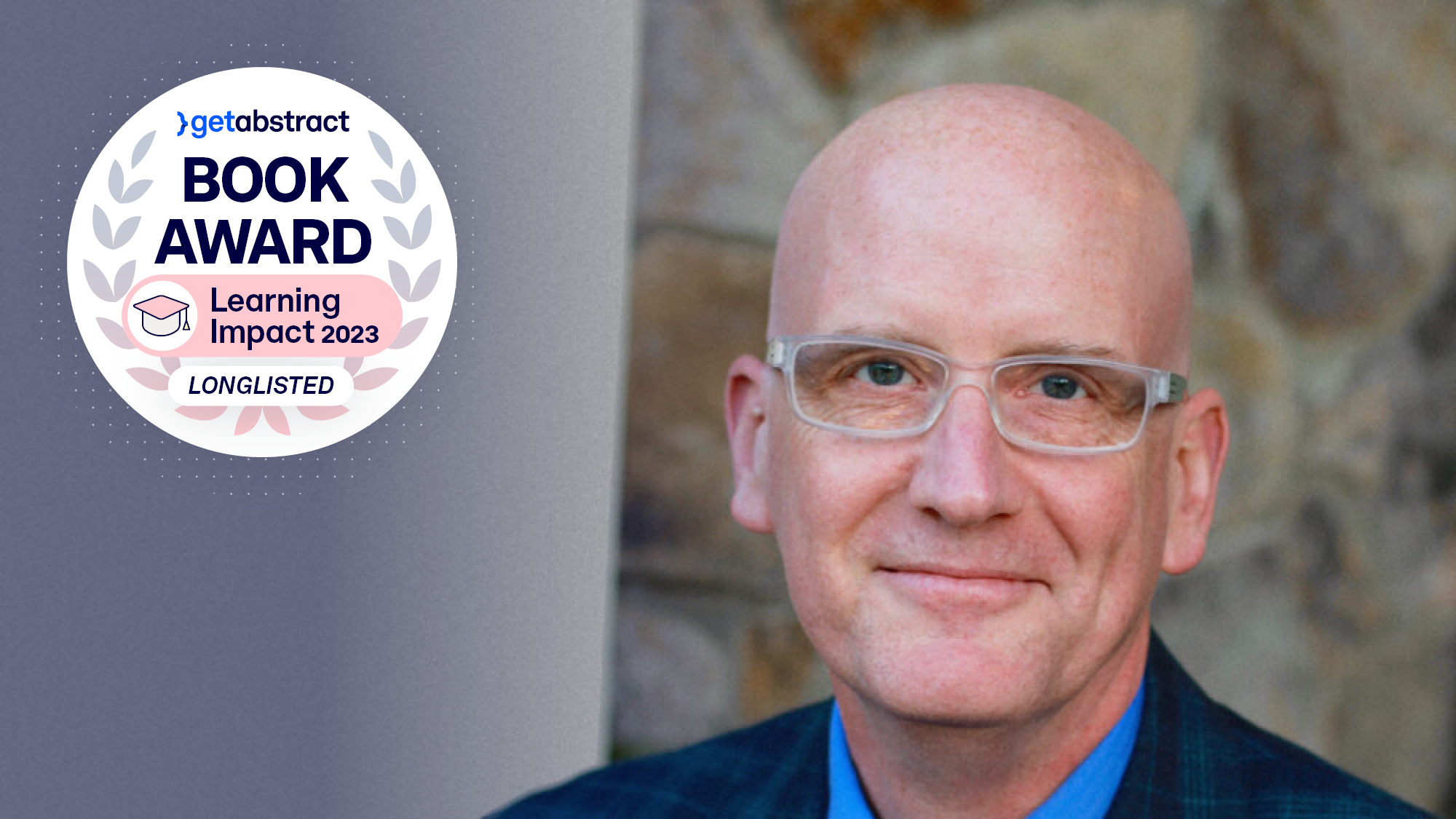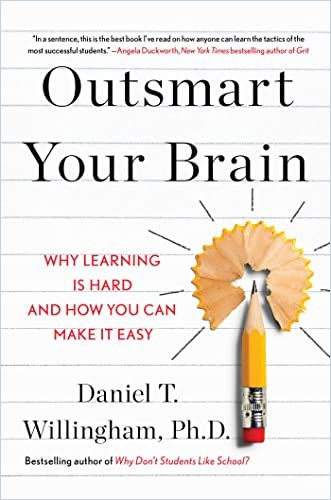“Motivation Alone Doesn’t Automatically Lead To Successful Learning.”

In Outsmart Your Brain, Psychology professor Daniel Willingham offers research-backed advice on how to train your brain for better learning. In this wide-ranging author interview, discover why motivation has little impact on knowledge retention, what the caveats of “self-directed” learning are, why you will never master “speed reading,” and why your need to acquire knowledge remains unchanged in the era of ChatGPT.
Very briefly, what brought you to write your latest book, Outsmart Your Brain?
Daniel Willingham: I’ve always been interested in problems of learning and memory. But interestingly, I’d never spent that much time applying that rather technical knowledge to my teaching. I only fully realized a few years ago that by the time students come to college, we have very high expectations about their ability to regulate their learning. In the early grades of school, it’s understood that the teacher is responsible for seeing that students learn. But by the time they get to college, they are expected to teach themselves a lot of complicated content. No one’s ever taught them how to do that. And most of them don’t know. So I decided to write a book about it.

Your book mostly addresses college students. How about more mature learners? Do people in middle age learn differently? Would you tweak some of your learning tips when addressing people in their 50s, for example?
I would not tweak the tips for someone in their 50s. When we talk about the brain’s basic architecture that supports memory, it’s not fundamentally different in a 50-year-old compared to an 18-year-old.
We tend to take it for granted that being interested in a subject makes it easier to learn about it. However, as you point out in the book, wanting to learn does not directly impact your ability to internalize your learnings. Can you speak to the “motivation” piece with regard to learning?
Interestingly, our casual observations of ourselves can lead to two conflicting statements: One is that, of course, it’s easier to learn something if you’re interested in it. But the other is that we have all kinds of information in our memory that we were never interested in learning – things like advertisements or celebrity gossip. You certainly didn’t study these things, but they have stuck with you nonetheless.
How about things we want to remember but can’t?
A good example is people’s names. You always want to remember the name of someone you meet, yet you often can’t remember it. Those casual observations indicate that we have things in our memory that we never wanted to learn, while other things we really wanted to learn don’t end up in memory. More formal experiments indicate that the mere desire to learn doesn’t really do anything yet.
So why does it feel so much easier to learn something when we’re interested?
Well, the first thing I’ll point out is that that’s not always true. I love cognitive psychology and neuroscience, yet I’m frequently bored at conferences, especially when a presentation is poorly done. All of us have had the experience of watching a documentary on a subject we are passionate about and ending up being bored.
The mere desire to learn doesn’t really do anything yet.
Daniel Willingham
Motivation alone doesn’t automatically lead to successful learning. However, motivation can indirectly aid learning if it prompts us to employ effective memory strategies. In short, desire alone may not be enough, but when it drives us to use proven memory techniques, it becomes beneficial.
With all the technological change going on, many professionals see their job roles transform and may need to learn things they are not interested in. How can we increase our interest in content that initially bores us?
The most important thing is to change your mindset about the task in front of you. If you wait for motivation to drive learning, you’re probably not going to learn. Motivation is much harder to manipulate than learning. Once you begin learning, however, motivation often follows. As you progress, the subject becomes more meaningful to you, and you are going to see how learning more about the subject will help you in the future. By persevering, you prove to yourself that you can stick with things even when they’re not very interesting. This reaffirms your commitment to professional growth, serving as a motivating factor in itself.
L&D professionals today put a lot of emphasis on fostering “self-directed learning.” What are the caveats of this approach? How can L&D ensure that the self-directed learning approach leads to tangible results?
The advantages of self-directed learning are obvious: It gives people a sense of autonomy. Traditional training often lacks engagement, with learners tuning out after a short time. Individualized learning allows you to choose what’s relevant to your goals and job. The downside is that learners often lack sufficient expertise to guide their own learning. For example, there’s a non-trivial likelihood that you’re going to select a bad course. Teachers not only provide instruction but also structure and progression. When you control your own learning, you miss those advantages of a teacher. To benefit from both autonomy and expert guidance, the key is to seek input from knowledgeable individuals to shape your self-directed learning effectively.
Motivation is much harder to manipulate than learning.
Daniel Willingham
Microlearning is another big trend in L&D. What are the pros and cons of microlearning?
Bite-sized microlearning units offer the advantage of making learning more manageable and less intimidating. But for learning to really stick with you, you need to revisit the material over the course of months. Microlearning offers a brief introduction to a topic rather than in-depth learning. It’s more fitting to label it as “exposure” rather than “learning.”
Or use it to revisit knowledge that you’ve acquired previously…
Absolutely.
Are you concerned that microlearning is crowding out deep learning experiences necessary to master a new subject area?
I do. But if you understand what microlearning is going to get you, it won’t crowd out deep learning because you’ll see it for what it is.
To benefit from both autonomy and expert guidance, the key is to seek input from knowledgeable individuals to shape your self-directed learning effectively.
Daniel Willingham
How would you recommend a busy professional structure their learning?
A question I am currently focused on is how to assess learning needs. Individual learning needs vary a lot. Taking a course may really make sense depending on what field you’re in and what you already know. So, for example, if you’re in risk management and have never taken a course in probability theory, it’s time for you to understand probability in a deep way because that underpins everything you do. Or you may need to acquire a specific technical skill, such as to use new software.
What about someone who is committed to continuous learning but has no immediate need to acquire specific academic or technical knowledge to succeed at their job?
Say, you are working in a field where you are frequently asked to solve novel problems. A good way to enhance your ability to think creatively is to get to know other parts of your organization. If you’re in accounting, how well do you know what goes on in operations? Exploring connections between your area and others can reveal new insights. Similarly, consider how your products/services relate to what other firms are offering. To foster creative thinking, draw inspiration from neighboring fields. Tap into ideas that might be uncommon within your company but are widely recognized elsewhere.
A good way to enhance your ability to think creatively is to get to know other parts of your organization.
Daniel Willingham
Let’s shift gears and dispel some common learning myths:
Myth no. 1: People have different “learning styles”
It’s amazing how persistent this idea is. It’s been around at least since the 1950s, but researchers have never found evidence to support it. Distinguishing between ‘learning styles’ and ‘learning abilities’ is crucial to understanding this topic. There’s no doubt that people differ in their abilities – one person may be good with words, while another may be good with numbers. In contrast, styles represent a preferred way of learning, not related to proficiency. While abilities vary, styles should be equally effective. Testing this involves exposing individuals to material in their preferred style and assessing their comprehension later. It turns out that people who think visually do no worse at recalling a story they have listened to than people who think in terms of words and whose learning style has been honored. Research shows no support for learning styles, despite common belief.
In other words, people have learning preferences but use the same brain processes to acquire knowledge…
Exactly. It’s like you have a circulatory system that works more or less the same way as everyone else’s. It’s not like evolution left us with six different models. The same goes for the brain: Our core cognitive abilities are much more similar across people than they are different.
Research shows no support for learning styles, despite common belief.
Daniel Willingham
Myth no. 2: Speed reading lets you absorb text rapidly without losing comprehension.
The notion of speed reading, although alluring, is a very persistent myth. You can skim, but you are constrained by the limited speed at which your eyes can move. Eye tracking experiments reveal that skimming pages sacrifices comprehension, as the eyes cannot grasp what they don’t rest on for at least a little bit. Speed reading courses often have you read a text at the beginning, time you and test your comprehension. Afterward, you’ll learn some speed reading techniques and then be given the exact same passage again, which you are asked to speed read this time. You are faster and better at answering the questions the second time around because you are already familiar with the text and not because of any speed reading method.
Myth no. 3: Reading a book is superior to listening to its audio version.
There is a lot of overlap between listening and reading in terms of comprehension. When children start school, they are already able to listen to language. When learning to read, they employ the same mental processes used for listening comprehension. Thus, reading doesn’t introduce entirely new comprehension mechanisms; it utilizes existing ones. Suppose you give people a reading comprehension test and administer it by reading the passages and questions aloud. Research shows that results are nearly equivalent to traditional text-based testing. That said, there are a few differences around the edges. Listening offers additional cues like prosody, aiding interpretation. Reading, however, offers the advantage of allowing you to backtrack and revisit sections. Many people prefer reading over listening when it comes to very technical and difficult text. But when it comes to comprehension, there is a lot of overlap between the two modes.
Myth no. 4: Smartphones make us dumb.
The things most of us do on smartphones – watch videos, scroll social media, play games – are not particularly enriching. But if you think of the pre-smartphone era, it’s not as if you spent all your downtime reading Shakespeare. We used to find other ways to waste time. The idea that smartphones are making us all stupid can be overdone. That said, critics are correct in asserting that these devices often steer us away from spending our time more wisely.
Does smartphone use affect our attention span?
I’ve long opposed the notion that attention span has notably declined due to digital technology. Nevertheless, I acknowledge the phenomenon, which I also feel in myself, that many of us have become reluctant to engage in sustained attention. However, there’s a difference between being unable to sustain attention and just not wanting to. I’ve argued that we are dealing with latter, though the two interpretations may not be mutually exclusive.
There’s a difference between being unable to sustain attention and just not wanting to.
Daniel Willingham
How do you think natural language processing tools like ChatGPT will change learning?
I don’t think these tools reduce the need for learning. Knowledge is necessary for effective thinking. One concern is that ChatGPT often provides inaccurate information, as it aggregates content without discernment. I’ve told my students that they will need to spend a fair amount of time fine-tuning prompts. Making your prompts better when you don’t know very much is hard. And it’s going to be an iterative process. As you learn more, you’ll get better at prompting. And once you get the output, you have to verify it. ChatGPT does a terrible job finding citations and sometimes simply makes stuff up. In the time it takes to verify all this information, you could have done your own research. The latter certainly helps with memorization. You will remember more if you do it yourself – and you may actually end up saving time.
Knowledge is necessary for effective thinking.
Daniel Willingham
Can you highlight a particular feature of human cognition that AI tools haven’t yet mastered?
AI tools like ChatGPT struggle with context comprehension—a strength of human cognition. Our brains excel at extracting relevant information and providing you with the shades of meaning you need at a particular moment and within a specific context.
Can you give an example?
If I say, ‘I’m moving to a new apartment across town, and I’m trying to figure out what I’m going to do with my piano,’ you immediately understand that there’s a particular feature of pianos that’s really relevant and important here, which is that pianos are heavy. Although you know a lot of other things about pianos, your brain is great at bringing forth only the feature of pianos that’s relevant in this particular context. It remains to be seen whether ChatGPT is going to improve on this.
How can ChatGPT assist students in their learning process? How can instructors and learners leverage tools like ChatGPT to improve learning outcomes?
University instructors have been grappling with this question intensely, especially over the summer. Initially, the emergence of ChatGPT in the spring mainly triggered concerns about widespread cheating. However, during the summer, perspectives shifted. People started considering the positive applications of ChatGPT. One interesting idea I’ve heard is that students could employ ChatGPT to generate practice exam questions, which can be genuinely beneficial. ChatGPT can also be usefully employed as a potent, Google-like resource, providing rapid and easy-to-understand answers to common sense questions – yet you will still need to verify the veracity of these answers.
About the Author
Daniel Willingham teaches psychology at the University of Virginia. His research focuses on applying cognitive psychology and neuroscience findings to K–12 education. His books include Why Don’t Students Like School? and When Can You Trust the Experts? Willingham also writes the “Ask the Cognitive Scientist” column for American Educator magazine.
More in the getAbstract Journal:








